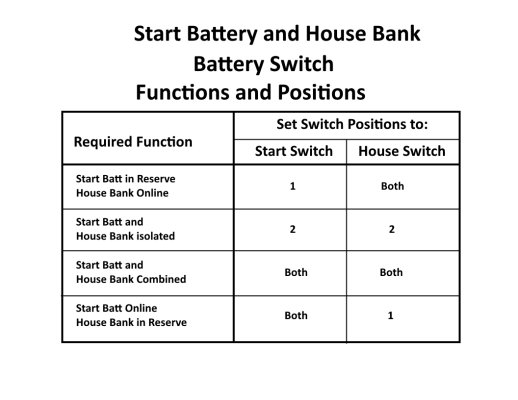Portage_Bay
Guru
- Joined
- Oct 19, 2015
- Messages
- 2,674
- Location
- United States
- Vessel Name
- Pacific Myst
- Vessel Make
- West Bay 4500
You may have seen a setup like this before, it was new to me when I purchased the boat. I thought it clever enough share with the forum.
The boat has a 6 golf car battery house bank and a single 8D for starting both main engines. The house bank and start batt each have their own 1,2,BOTH switch. The two switches are tied together on the #1 post.
Rod on Marine HowTo has a good article on 1,2,BOTH switches 1,2,BOTH Battery Switch Considerations where he talks about too often the way the switch is wired there is not true isolation, the idea of using the house bank to start engines if it's large enough and keeping a start batt / bank in reserve.
This two switch configuration address these issues. Have a look at the circuitry and a usage placard I've generated and posted at the switches.
Using the "Start" switch alone the operator can select between the two most useful modes:
- House Bank does it all keeping the start batt in reserve
or
- Total isolation of house bank and start batt
Using both switches the operator can also
- Combine the batteries
or
- Run all from the start batt
It is worth noting the PO ran the alternator outputs directly to the batteries reducing the risk of breaking the connection with engine(s) running and blowing the alternator.
This set up does not meet Rod's concept of keeping it simple and easy to reduce human error. It requires an understanding of the wiring or at least a willingness to read the usage placard before turning switches.
The boat has a 6 golf car battery house bank and a single 8D for starting both main engines. The house bank and start batt each have their own 1,2,BOTH switch. The two switches are tied together on the #1 post.
Rod on Marine HowTo has a good article on 1,2,BOTH switches 1,2,BOTH Battery Switch Considerations where he talks about too often the way the switch is wired there is not true isolation, the idea of using the house bank to start engines if it's large enough and keeping a start batt / bank in reserve.
This two switch configuration address these issues. Have a look at the circuitry and a usage placard I've generated and posted at the switches.
Using the "Start" switch alone the operator can select between the two most useful modes:
- House Bank does it all keeping the start batt in reserve
or
- Total isolation of house bank and start batt
Using both switches the operator can also
- Combine the batteries
or
- Run all from the start batt
It is worth noting the PO ran the alternator outputs directly to the batteries reducing the risk of breaking the connection with engine(s) running and blowing the alternator.
This set up does not meet Rod's concept of keeping it simple and easy to reduce human error. It requires an understanding of the wiring or at least a willingness to read the usage placard before turning switches.


